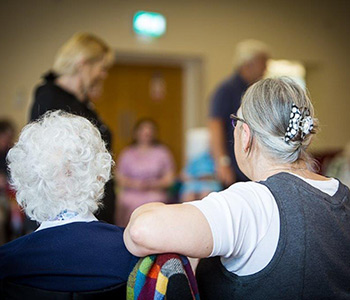You may or may not have heard the term “Person-Centred care” used in the Tibbs Dementia community. It is, in fact, one of the core values which underpins everything we do. So, as it is the time of our sixth anniversary, I thought it might be a good idea to revisit our roots.
Okay – so what does it mean? And why is it such a big deal.?
It means that as an organisation we believe that each person has a unique “personhood” at the core of their being which continues to exist in spite of severe cognitive decline. It is the essence of the person. The idea was originally developed by the psychologist Carl Rogers and was then applied to dementia by Tom Kitwood in the 1990’s. Kitwood, with whom I had the privilege of working on a research project at the end of his life, developed his ideas as a direct challenge to the culture in dementia care which existed at that time. People with dementia were regarded as “nonpersons” and this was the prevailing attitude. In the UK people remained at home with their families until their loss of memory, impaired language and “Challenging behaviour” (or behaviours of protest and disruption as Kitwood described them) meant that the family could no longer cope. Most people were then sent to the asylums where they were “out of sight and out of mind”. I was a regular visitor to Fairfield – our local asylum – because of my job. It was so large at that time that it spread between the villages of Arlesey and Stotfold. The patients in the asylum wards I had to visit did indeed fit the stereotypes – people sitting mute, staring vacantly into space, or behaving in a very bizarre fashion. There was a great reliance on the use of anti-psychotic medication to control these behaviours so the people who were sitting in a near comatose state were probably over medicated. It was this kind of care environment with its underlying philosophy that Kitwood described as “Malign Social Psychology”. Of course, there had always been some staff who were genuinely caring and had done their best to bring simple kindness into their work, but the prevailing culture was as I have described.
The asylums were all closed down by the end of the 1990’s and their place was taken by private care homes – either residential or nursing. Unfortunately, as I have written before, the asylums cast a long shadow. Many of the staff in the lovely new care homes had worked in the asylums or been trained by people who had. Little good staff training was available, and staff learned on the job. So, the old culture persisted. Tasks to be completed were thought to be much more important than the people. I wish I could say that this attitude is a thing of the past. But sadly, it is proving very difficult to eradicate in spite of many examples of excellent care where the new culture is flourishing.
What most people failed to realise was that there was a connection between the way people were treated and the way they behaved. We did not understand then that “challenging behaviour” was often an attempt to communicate the way that the person was feeling. The more they were ignored, the more they would metaphorically turn up the volume of the behaviour. Most people working in the field of dementia care did not understand that the personhood of the people with dementia was being eroded by the way other people were treating them.
Rather strangely you may think, I discovered a really neat way to describe the person-centred approach in my South African roots. There is a traditional Zulu proverb which goes “Umuntu ukumuntu ngibanye abantu”. This means “A person becomes a person through other people”. Fascinating that this knowledge is owned by a traditional African culture and is unknown in so-called developed Britain.
Back to Kitwood. His work was largely directed at trying to change the culture of institutional care which was clearly so bad at the time he was working. How relevant is it if you are living with a person with dementia at home?
I seem to have had a lot of conversations since my last blog about the challenge of communicating important information to professionals when you have both been invited to a clinic appointment, a visit to the doctor, a Continuing Health Care assessment or a care agency. So many carer/supporters struggle with this because they are reluctant to humiliate their husband/wife/mother/father by describing just how many skills and abilities have been lost. People are instinctively respecting the personhood of their family member. It is now considered good practice among professionals to see the person with dementia and their carer together. Excellent. It is the person with dementia’s brain which is deteriorating after all. But some thought needs to be given about redressing the imbalance. I have heard suggestions like emailing beforehand (but doctors may not read emails), writing down what you need to say and passing it to the doctor/social worker/panel at the start of the interview with a discreet request that they take a minute to read it first. If the professional comes to the house, you may follow them out to the car for a private chat………
So, it seems that we do instinctively respect the Personhood of the one we care for in those situations. But it may be more of a challenge when the other person needs to be constantly asked to do something or needs help with personal care.
A PERSON BECOMES A PERSON THROUGH OTHER PEOPLE.
As I said at the beginning, it is one of our founding principles, but we probably need to keep reminding each other- both as members of the Tibbs organisation and as friends – how important it is.




